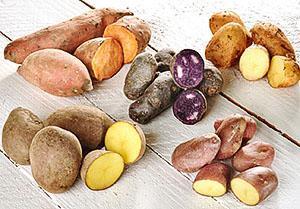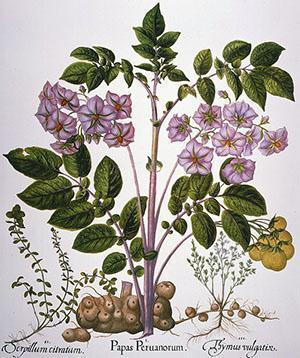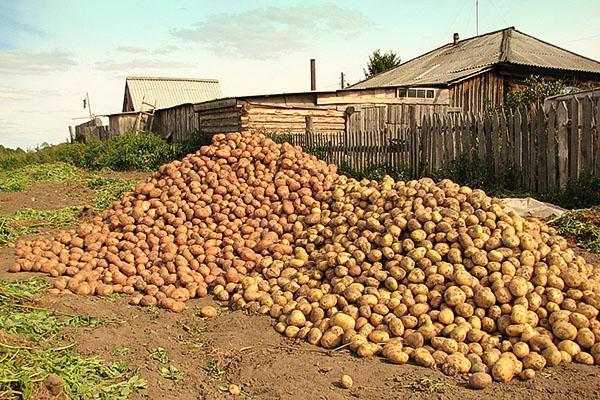Types of potatoes: known, healthy and not so
 Wild potatoes are a perennial plant in the Solanaceae family, native to South America. For the sake of tubers, potatoes have been cultivated for more than two and a half thousand years. And modern breeders and biologists are tirelessly working on new varieties.
Wild potatoes are a perennial plant in the Solanaceae family, native to South America. For the sake of tubers, potatoes have been cultivated for more than two and a half thousand years. And modern breeders and biologists are tirelessly working on new varieties.
Wild precursors of all cultivated potatoes

- The tuberous or Chilean potato, native to Peru and Bolivia, is now widely distributed in 130 temperate regions of the world. The spread of this type of potato began in the 16th century, and by the 19th century the crop became widespread, becoming the fifth in the ranking of agricultural plants.
- The Andean potato, native to the South American continent, has played a decisive role in the development of many modern varieties and hybrids due to polymorphism.
The tubers, for which potatoes are cultivated, begin to form when the first buds appear on the bushes. From a biological point of view, a tuber is a hypertrophied rhizome, which becomes a kind of storage for nutrients.
Read also:potato gratin recipe with photo step by step.
Potato classification by purpose
 Today, depending on the content of sugars, vitamins, proteins and starch in potato tubers, varieties are divided into four groups.
Today, depending on the content of sugars, vitamins, proteins and starch in potato tubers, varieties are divided into four groups.
- Table potatoes are a vegetable that occupies one of the first places in the diet of many peoples. Tubers of these varieties are large or medium in size. They are round, with a thin skin and not too deep eyes. When creating table varieties, special attention is paid to the content of vitamin C and starch in tubers, which should not exceed 12-18%.
- Technical potatoes are raw materials for the production of alcohol and starch, therefore, the increased, more than 16%, content of this component in such varieties is only welcome. But technical potatoes are poor in protein.
- Fodder potatoes produce large, starchy, protein-rich tubers. Since the importance of potatoes as a fodder crop has recently grown, it is extremely important yield varieties.
- Universal varieties can combine the properties of all the listed groups.
For many years of presence on summer cottages and potato farm plantations, everyone is accustomed to the fact that the outer color of tubers can be almost white, and brown-yellow, pink or almost purple. But on the cut, until recently, the potatoes remained white or slightly yellow.
Why do purple and red potatoes have their unusual color?
 But today breeders offer very unusual types of potatoes with multi-colored pulp for planting. The amazing color range of potatoes is due to the biochemical composition, or rather, anthocyanins and carotenoids. While tubers with traditional white flesh contain no more than 100 mg of provitamin A per 100 grams of potatoes, then varieties with a yellow core contain twice as much of this substance. And the brighter the color of the tuber, the higher the concentration of provitamin A. In orange and red potatoes, its content reaches 500–2000 mg.
But today breeders offer very unusual types of potatoes with multi-colored pulp for planting. The amazing color range of potatoes is due to the biochemical composition, or rather, anthocyanins and carotenoids. While tubers with traditional white flesh contain no more than 100 mg of provitamin A per 100 grams of potatoes, then varieties with a yellow core contain twice as much of this substance. And the brighter the color of the tuber, the higher the concentration of provitamin A. In orange and red potatoes, its content reaches 500–2000 mg.
 The concentration of anthocyanins, which provide a purple, lilac or violet color of the pulp and rind, in brightly colored tubers is two dozen times higher than in light-colored table varieties. For 100 grams of purple or blue potatoes, there can be 9 to 40 mg of anthocyanins. Moreover, the concentration of this natural dye and carotene is always higher in the peel. But inside the pulp, these substances can be unevenly distributed, which made it possible for breeders to get plants with variegated tubers both outside and inside.
The concentration of anthocyanins, which provide a purple, lilac or violet color of the pulp and rind, in brightly colored tubers is two dozen times higher than in light-colored table varieties. For 100 grams of purple or blue potatoes, there can be 9 to 40 mg of anthocyanins. Moreover, the concentration of this natural dye and carotene is always higher in the peel. But inside the pulp, these substances can be unevenly distributed, which made it possible for breeders to get plants with variegated tubers both outside and inside.
 In addition, red, blue or purple potatoes have twice the amount of bioflavonoids than traditional varieties with light-colored flesh. But the starch in colored tubers is much less, so they can be used for dietary and medical nutrition, and sometimes even raw. Active selection of all new colored varieties and their growing popularity among gardeners allow us to say that not all the beneficial aspects of potatoes have been studied and used. Studies conducted by biologists and doctors in Korea and the United States have shown that the introduction of purple and red tubers into the diet helps the body to resist atherosclerosis and cancer.
In addition, red, blue or purple potatoes have twice the amount of bioflavonoids than traditional varieties with light-colored flesh. But the starch in colored tubers is much less, so they can be used for dietary and medical nutrition, and sometimes even raw. Active selection of all new colored varieties and their growing popularity among gardeners allow us to say that not all the beneficial aspects of potatoes have been studied and used. Studies conducted by biologists and doctors in Korea and the United States have shown that the introduction of purple and red tubers into the diet helps the body to resist atherosclerosis and cancer.
The substances in red and purple potatoes have a beneficial effect on the state of the organs of vision and blood vessels, prevent premature aging and help fight heart disease.
Red and blue potatoes from CIS breeders
 Not only Western breeders, but also scientists from Belarus and Russia are engaged in breeding varieties that give tubers with colored pulp. Employees of the Research Institute of Plant Cultivation of the Russian Federation have obtained high-yielding hybrids of purple and red potatoes, which have been successfully zoned in the middle zone of the country.
Not only Western breeders, but also scientists from Belarus and Russia are engaged in breeding varieties that give tubers with colored pulp. Employees of the Research Institute of Plant Cultivation of the Russian Federation have obtained high-yielding hybrids of purple and red potatoes, which have been successfully zoned in the middle zone of the country.
But the first colored potatoes in Russia were obtained in the Tomsk region. Here, since 2007, varieties of orange, pink purple and blue potatoes have been created. Siberian scientists have zoned and are already massively growing several interesting types of potatoes with a high content of carotene and anthocyanins.
 Thanks to the seed material received from the Peruvian center of potato growing, Research Institute of Plant Production. Vavilov, as well as from research centers in the USA and Germany, Belarusian researchers engaged in promising developments have managed to create more than seventy hybrids, which are not inferior in brightness to world analogues.
Thanks to the seed material received from the Peruvian center of potato growing, Research Institute of Plant Production. Vavilov, as well as from research centers in the USA and Germany, Belarusian researchers engaged in promising developments have managed to create more than seventy hybrids, which are not inferior in brightness to world analogues.
Conditionally useful types of potatoes
The demand for brightly colored potato species, most often obtained from interspecific crossing and careful selection, is steadily growing in the world, which is facilitated by the curiosity of gardeners and the pronounced useful properties of such tubers. Biological research is not limited to such selection.
 A genetically modified Russet Burbank New Leaf cultivar has been developed by one of the largest plant genetics companies based on red-brown-skinned potatoes distributed in the United States.
A genetically modified Russet Burbank New Leaf cultivar has been developed by one of the largest plant genetics companies based on red-brown-skinned potatoes distributed in the United States.
- Outwardly, such a potato is little distinguishable from the usual yellow or white.
- It has a yellowish crumbly flesh and a leathery, dense rind.
- When grown, the variety shows high yields and resistance to diseases and damage by the Colorado potato beetle.
- It is used by some of the largest fast food chains in the world.
- This variety, prevalent in plantings in the United States and Australia, is used as food and fodder potatoes.
 But as a result of studies carried out in 2009 by Russian doctors, agricultural plants with altered genetics, including similar types of potatoes, are not recognized as useful for humans. In experimental animals that ate such tubers, pathological changes in the internal organs were revealed; therefore, genetically modified potatoes are not allowed for distribution and cultivation in Russia.
But as a result of studies carried out in 2009 by Russian doctors, agricultural plants with altered genetics, including similar types of potatoes, are not recognized as useful for humans. In experimental animals that ate such tubers, pathological changes in the internal organs were revealed; therefore, genetically modified potatoes are not allowed for distribution and cultivation in Russia.
No matter how great the popularity of colored tubers, there is one type of potato with an unusual color, which only harm a person.This is a well-known green potato for gardeners, which has become so after a long stay in the light.
Under the influence of illumination, a natural alkaloid, solanine, begins to accumulate in tubers. So the plant protects tubers from environmental influences and diseases, but for humans, solanine is not at all useful.
Edible sweet potato, sweet potato
 If real potatoes are a vegetable related to nightshades, peppers and tomatoes, then for the sweet potato, which gives large starchy tubers, the closest relatives will be wild bindweed and garden morning glory.
If real potatoes are a vegetable related to nightshades, peppers and tomatoes, then for the sweet potato, which gives large starchy tubers, the closest relatives will be wild bindweed and garden morning glory.
Grown today in many Asian countries, Africa and the United States, sweet potato yams are highly regarded for their nutritional and health benefits. It is a food culture in demand all over the world, whose homeland is the mountainous regions of Colombia and Peru. Like ordinary potatoes, sweet potatoes, depending on the variety, can produce tubers of not very different colors.
 The long-known varieties are so rich in carotene that their orange tubers are superior to carrots in health benefits. The sweet potato is successfully grown, containing a large amount of anthocyanins, showing properties similar to the traditional purple potato. But in terms of the content of calcium, carbohydrates and iron, potatoes are inferior to sweet potatoes, which, moreover, are one and a half times more nutritious.
The long-known varieties are so rich in carotene that their orange tubers are superior to carrots in health benefits. The sweet potato is successfully grown, containing a large amount of anthocyanins, showing properties similar to the traditional purple potato. But in terms of the content of calcium, carbohydrates and iron, potatoes are inferior to sweet potatoes, which, moreover, are one and a half times more nutritious.
- In the tropics and subtropics, sweet potatoes are grown as a perennial crop, and in this case the tubers even reach 10 kilograms.
- In a temperate climate in an annual crop, it is possible to grow the earliest varieties, whose tubers weigh about 3 kg. In Russia, there is a successful experience of cultivating sweet potatoes with a growing season of up to 110 days.
 In the world, many varieties of fruitful sweet potatoes have been bred, differing not only in ripening times, the color of the pulp and rind of the tubers, but also in taste. While some sweet potato dishes do have a sweet taste, others cannot be distinguished from traditional potatoes. There are varieties with a creamy and nutty flavor.
In the world, many varieties of fruitful sweet potatoes have been bred, differing not only in ripening times, the color of the pulp and rind of the tubers, but also in taste. While some sweet potato dishes do have a sweet taste, others cannot be distinguished from traditional potatoes. There are varieties with a creamy and nutty flavor.